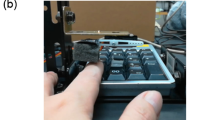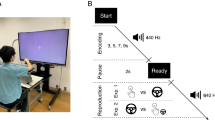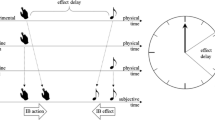Abstract
An action that produced an effect is perceived later in time compared to an action that did not produce an effect. Likewise, the effect of an action is perceived earlier in time compared to a stimulus that was not produced by an action. Despite numerous studies on this phenomenon—referred to as Intentional Binding effect (IB)—the underlying mechanisms are still not fully understood. Typically, IB is investigated in settings where the action produces just one single effect, whereas in everyday action contexts, it rather causes a sequence of effects before leading to the desired outcome. Therefore, we investigated IB of two consecutive effects. We observed substantially more IB of a first effect tone compared to a second tone. This pattern was observed for second tones that were temporally predictable (Exp. 1) or not (Exp. 2 and 3). Interestingly, the second tone yielded stronger IB when it was less delayed (Exp. 4). Thus, also an event occurring later in an unfolding action–effect sequence can be bound to its causing action, but it might be less bound to the action than a first effect. Instead of the fact that it is the second of two consecutive effects, this, however, rather seems to be influenced by the longer delay of a second and, therefore, later occurring effect.


Similar content being viewed by others
Notes
The effects of the causality attribution were analyzed independently of the main analysis of an effect sequence with two effects. However, neither the main effect of causality attribution nor any interaction with this factor was significant and is, thus, not described further (uploaded in Open Science).
Furthermore, a repeated-measures ANOVA (action vs. first tone vs. second tone) with Experiment as between-subjects factor has been conducted to compare IB of action, first, and second tones of Experiment 1 and Experiment 3. It revealed no significant interaction of IB of action, first, and second tones and Experiment, F(2, 92) = 0.02, p > .250, η 2p = .00.
IB did not differ significantly for first (Experiment 1 to Experiment 3) and second tones (Experiment 4) occurring after a delay of 500 ms, F(3, 92) = 0.55, p > .250.
References
Caspar, E. A., Desantis, A., Dienes, Z., Cleeremans, A., & Haggard, P. (2016). The sense of agency as tracking control. PLoS ONE, 11(10), e0163892. doi:10.1371/journal.pone.0163892.
Dignath, D., Pfister, R., Eder, A. B., Kiesel, A., & Kunde, W. (2014). Representing the hyphen in action–effect associations: Automatic acquisition and bidirectional retrieval of action–effect intervals. Journal of Experimental Psychology. Learning, Memory, and Cognition, 40(6), 1701–1712. doi:10.1037/xlm0000022.
Fereday, R., & Buehner, M. J. (2015). Temporal binding and internal clocks: Is clock slowing general or specific? In Proceedings of the 37th Annual Meeting of the Cognitive Science Society (pp. 686–691).
Garaizar, P., Cubillas, C. P., & Matute, H. (2016). A HTML5 open source tool to conduct studies based on Libet’s clock paradigm. Scientific Reports, 6, 32689. doi:10.1038/srep32689.
Greenwald, A. G. (1970). A double stimulation test of ideomotor theory with implications for selective attention. Journal of Experimental Psychology, 84(3), 392–398. doi:10.1037/h0029282.
Greville, W. J., & Buehner, M. J. (2010). Temporal predictability facilitates causal learning. Journal of Experimental Psychology: General, 139(4), 756–771. doi:10.1037/a0020976.
Greville, W. J., & Buehner, M. J. (2016). Temporal predictability enhances judgments of causality in elemental causal induction from both intervention and observation. The Quarterly Journal of Experimental Psychology, 69(4), 678–697.
Haering, C., & Kiesel, A. (2012). Time in action contexts: Learning when an action effect occurs. Psychological Research, 76(3), 336–344. doi:10.1007/s00426-011-0341-8.
Haering, C., & Kiesel, A. (2014). Intentional binding is independent of the validity of the action effect’s identity. Acta Psychologica, 152, 109–119. doi:10.1016/j.actpsy.2014.07.015.
Haggard, P., Aschersleben, G., Gehrke, J., & Prinz, W. (2002a). Action, binding, and awareness. In W. Prinz & B. Hommel (Eds.), Common mechanisms in perception and action: Attention and performance (pp. 266–285). Oxford: Oxford University Press.
Haggard, P., Clark, S., & Kalogeras, J. (2002b). Voluntary action and conscious awareness. Nature Neuroscience, 5(4), 382–385. doi:10.1038/nn827.
Haggard, P., Poonian, S. K., & Walsh, E. (2009). Representing the consequences of intentionally inhibited actions. Brain Research, 1286, 106–113. doi:10.1016/j.brainres.2009.06.020.
Herbart, J. F. (1825). Psychologie als Wissenschaft neu gegründet auf Erfahrung, Metaphysik und Mathematik. Zweiter, analytischer Teil. Königsberg, Deutschland: August Wilhelm Unzer.
Hoffmann, J., Berner, M., Butz, M. V., Herbort, O., Kiesel, A., Kunde, W., & Lenhard, A. (2007a). Explorations of anticipatory behavioral control (ABC): A report from the cognitive psychology unit of the University of Würzburg. Cognitive Processing, 8(2), 133–142. doi:10.1007/s10339-007-0166-y.
Hoffmann, J., Butz, M. V., Herbort, O., Kiesel, A., & Lenhard, A. (2007b). Spekulationen zur Struktur ideo-motorischer Beziehungen. Zeitschrift Für Sportpsychologie, 14(3), 95–103. doi:10.1026/1612-5010.14.3.95.
Hommel, B., Müsseler, J., Aschersleben, G., & Prinz, W. (2001). The Theory of Event Coding (TEC): A framework for perception and action planning. Behavioral and Brain Sciences, 24(5), 849–937. doi:10.1017/S0140525X01000103.
Humphreys, G. R., & Buehner, M. J. (2009). Magnitude estimation reveals temporal binding at super-second intervals. Journal of Experimental Psychology: Human Perception and Performance, 35(5), 1542–1549. doi:10.1037/a0014492.
James, W. (2011). The principles of psychology (Original work published 1890). Lawrence, KS: Digireads. com.
Janczyk, M., Durst, M., & Ulrich, R. (2017). Action selection by temporally distal goal states. Psychonomic Bulletin & Review, 24(2), 467–473. doi:10.3758/s13423-016-1096-4.
Libet, B., Gleason, C. A., Wright, E. W., & Pearl, D. K. (1983). Time of conscious intention to act in relation to onset of cerebral activity (readiness potential). The unconscious initiation of a freely voluntary act. Brain, 106(3), 623–642. doi:10.1093/brain/106.3.623.
Moore, J. W., Lagnado, D., Deal, D. C., & Haggard, P. (2009a). Feelings of control: Contingency determines experience of action. Cognition, 110(2), 279–283. doi:10.1016/j.cognition.2008.11.006.
Moore, J. W., Middleton, D., Haggard, P., & Fletcher, P. C. (2012). Exploring implicit and explicit aspects of sense of agency. Consciousness and Cognition, 21(4), 1748–1753. doi:10.1016/j.concog.2012.10.005.
Moore, J. W., Wegner, D. M., & Haggard, P. (2009b). Modulating the sense of agency with external cues. Consciousness and Cognition, 18(4), 1056–1064. doi:10.1016/j.concog.2009.05.004.
Nolden, S., Haering, C., & Kiesel, A. (2012). Assessing intentional binding with the method of constant stimuli. Consciousness and Cognition, 21(3), 1176–1185. doi:10.1016/j.concog.2012.05.003.
Obhi, S. S., & Hall, P. (2011). Sense of agency and intentional binding in joint action. Experimental Brain Research, 211(3–4), 655–662. doi:10.1007/s00221-011-2675-2.
Pfister, R., Janczyk, M., & Kunde, W. (2013). Editorial: Action effects in perception and action. Frontiers in Psychology, 4, 223. doi:10.3389/fpsyg.2013.00223.
Priemer, M. (2008). Audacity kompakt—Professionelle Soundbearbeitung mit dem besten freien Audioeditor. Saarbrücken, Deutschland: Bomotes.
Ruess, M., Thomaschke, R., & Kiesel, A. (2017). The time course of intentional binding. Attention, Perception, & Psychophysics, 79(4), 1–9. doi:10.3758/S13414-017-1292-Y.
Schneider, W., Eschmann, A., & Zuccolotto, A. (2012). E-Prime user’s guide. Pittsburgh, PA: Psychology Software Tools Inc.
Shin, Y. K., Proctor, R. W., & Capaldi, E. J. (2010). A review of contemporary ideomotor theory. Psychological Bulletin, 136(6), 943–974. doi:10.1037/a0020541.
Thomaschke, R., Hopkins, B., & Miall, R. C. (2012). The planning and control model (PCM) of motorvisual priming: Reconciling motorvisual impairment and facilitation effects. Psychological Review, 119(2), 388–407. doi:10.1037/a0027453.
Walsh, E., & Haggard, P. (2013). Action, prediction, and temporal awareness. Acta Psychologica, 142(2), 220–229. doi:10.1016/j.actpsy.2012.11.014.
Weller, L., Schwarz, K. A., Kunde, W., & Pfister, R. (2016). Was it me?—Filling the interval between action and effects increases agency but not sensory attenuation. Biological Psychology, 123, 241–249. doi:10.1016/j.biopsycho.2016.12.015.
Wen, W., Yamashita, A., & Asama, H. (2015). The influence of action-outcome delay and arousal on sense of agency and the intentional binding effect. Consciousness and Cognition, 36, 87–95. doi:10.1016/j.concog.2015.06.004.
Wenke, D., & Haggard, P. (2009). How voluntary actions modulate time perception. Experimental Brain Research, 196(3), 311–318. doi:10.1007/s00221-009-1848-8.
Wenke, D., Waszak, F., & Haggard, P. (2009). Action selection and action awareness. Psychological Research, 73(4), 602–612. doi:10.1007/s00426-009-0240-4.
Wolpe, N., Haggard, P., Siebner, H. R., & Rowe, J. B. (2013). Cue integration and the perception of action in intentional binding. Experimental Brain Research, 229(3), 467–474. doi:10.1007/s00221-013-3419-2.
Wundt, W. (1887). Grundzüge der physiologischen Psychologie (3rd ed.). Leipzig, Deutschland: Wilhelm Engelman.
Funding
The study was funded by Deutsche Forschungsgemeinschaft (Grant Nr. KI.1388/3-2).
Author information
Authors and Affiliations
Corresponding author
Ethics declarations
Conflict of interest
All authors declare that they have no conflict of interest.
Ethical approval
All procedures performed in studies involving human participants were in accordance with the ethical standards of the institutional and/or national research committee and with the 1964 Helsinki declaration and its later amendments or comparable ethical standards.
Informed consent
Informed consent was obtained from all individual participants included in the study. No animals were involved in any of the experiments.
Additional information
Raw data are available in Open Science https://osf.io/y85wr/?view_only=e0017be09ffb4e64aa970110200926bb.
Appendix A: mean baseline and experimental estimates and resultant intentional binding in experiment 1 to experiment 4
Appendix A: mean baseline and experimental estimates and resultant intentional binding in experiment 1 to experiment 4
See Table 1.
Rights and permissions
About this article
Cite this article
Ruess, M., Thomaschke, R., Haering, C. et al. Intentional binding of two effects. Psychological Research 82, 1102–1112 (2018). https://doi.org/10.1007/s00426-017-0892-4
Received:
Accepted:
Published:
Issue Date:
DOI: https://doi.org/10.1007/s00426-017-0892-4




